The Awestruck Author Zephyr Carlyle Standing in the Presence of the Gods at Besakih
In florid travel guides, Bali’s Besakih Temple is often listed as a ”must-see attraction.” In this case, believe the hype. Pura Basakih is called the ”Mother of All Temples” – [Pura is the Bali word for ”temple”] Pura Besakih is the holiest of Bali’s ten thousand (10,000) Hindu temples. Besakih is not one huge Temple; rather, it is a sprawling complex with many, many Temples. Besakih is a labyrinth of ancient architecture, cradled on a 3,000 foot hilltop. This elevation gives Pura Besakih a commanding height as it is perched on the slope slouching towards Mt. Agung, the highest point in Bali. This vantage point gives panoramic views below of the tropical forest-canopy. The observer can trace the movement as the ground yields ever higher to the soaring mountain that culiminates in the mishapen rim (volcano caldera) atop Mount Agung.
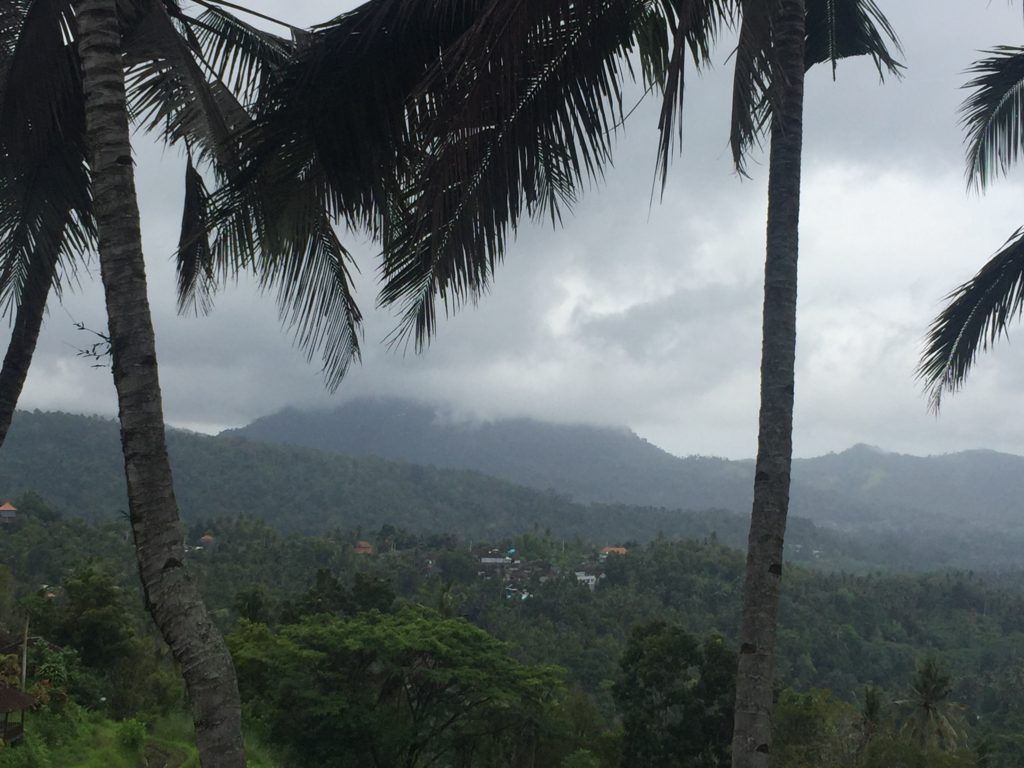
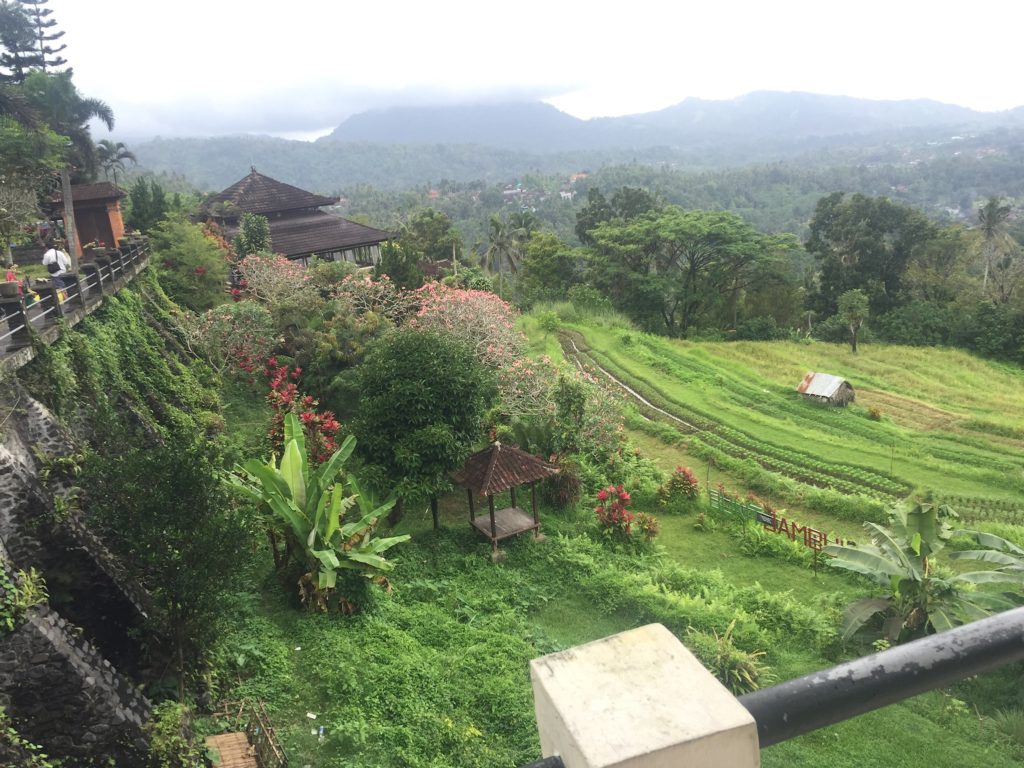
March, 2022 by Made Victor (the Bali name of writer Zephyr Carlyle) Besakih Temple is, in every way, truly a beauty to behold. If certain points on Earth are “power vortexes,” a common belief among New Agers, then Besakih is the mother lode of sacred energy. The New Age dharma bums are not the first to see Besakih as a power vortex. The locals have believed this for a long, long time. According to ancient tradition, Besakih was founded by the hoary Hindu Priest, Rsi Markandeya:
“Rsi Markandeya, an ancient Hindu priest from Java, led his devotees on a second trip to Bali as the first Bali trip ended in failure. Upon returning to Bali, the priest was drawn to a new location where the two branches of the river Wos converged. Rsi Markandeya was pulled there by the intense energy and light which emanated from this spot. Rsi Markandeya was inspired to meditate there and while doing so, received a strong message from the Gods. They told him to proceed to Mount Agung (Bali’s center of spirituality), and there he was to bury five precious metals (Panca Datu) in the ground as a foundation of power for the temple of Besakih (known in Bali as the Mother Temple.)” [lightly edited for clarity. ZVC]
(https://www.sabandari.com/how-the-village-of-ubud-came-to-be/).
The miracle of Besakih are not just relegated to ancient lore. The living Gods still oversee Pura Besakih and show their benevolence on the Temple and the faithful. This was dramatically demonstrated as Besakih was miraculously spared from destruction in the 1963 Mount Agung conflagration, set out below.
As Pura Besakih is sacred; Hindu supplicants and ANY visitor must show due respect, if they want to enter this holy ground. One way to demonstrate respect is by outward appearance; an idea that also follows the ancient Latin proverb: “clothes make the man” Thus, before entering the gates of Pura Besakih, ALL men and women must wear respectful traditonal clothing, with sarong skirts as a minimum standard. There is also a bunch of related regalia, not required but smiled upon: odd looking hats for the men (udon), attractive but colorful blouses for women (kebaya) commonly in yellow,; wide cloth sashes (selendang) for all, plus other fashion accessories. The locals all wear the obligatory sandals. The standard for admittance: No sarong, no selendang, no temple service.
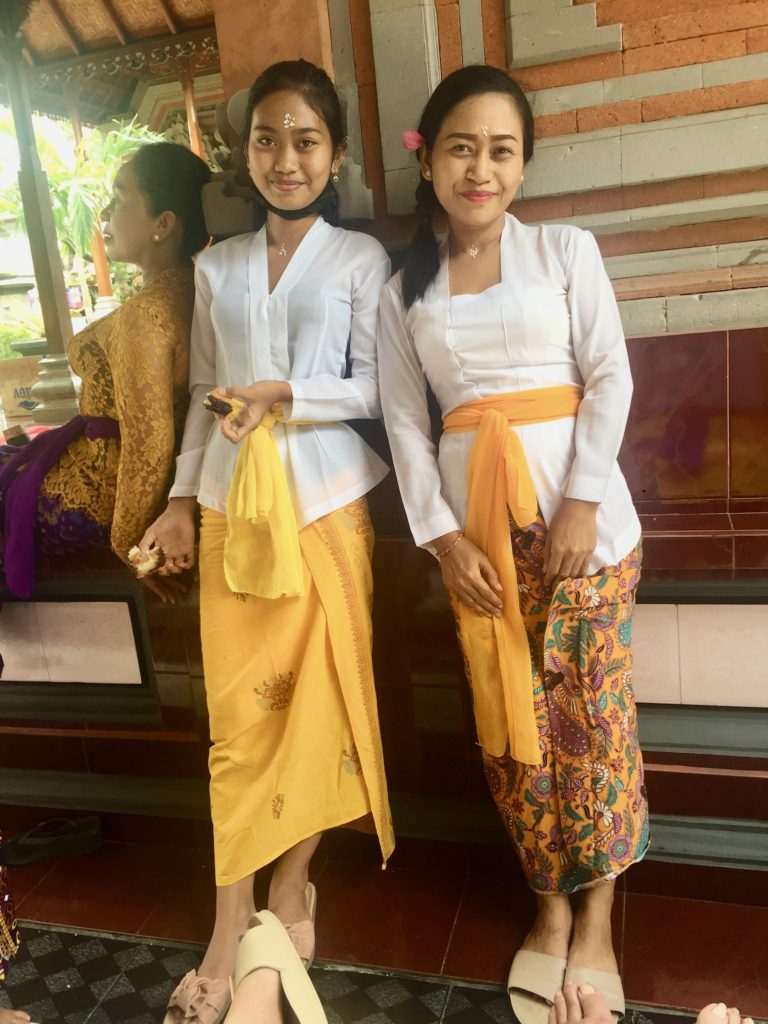
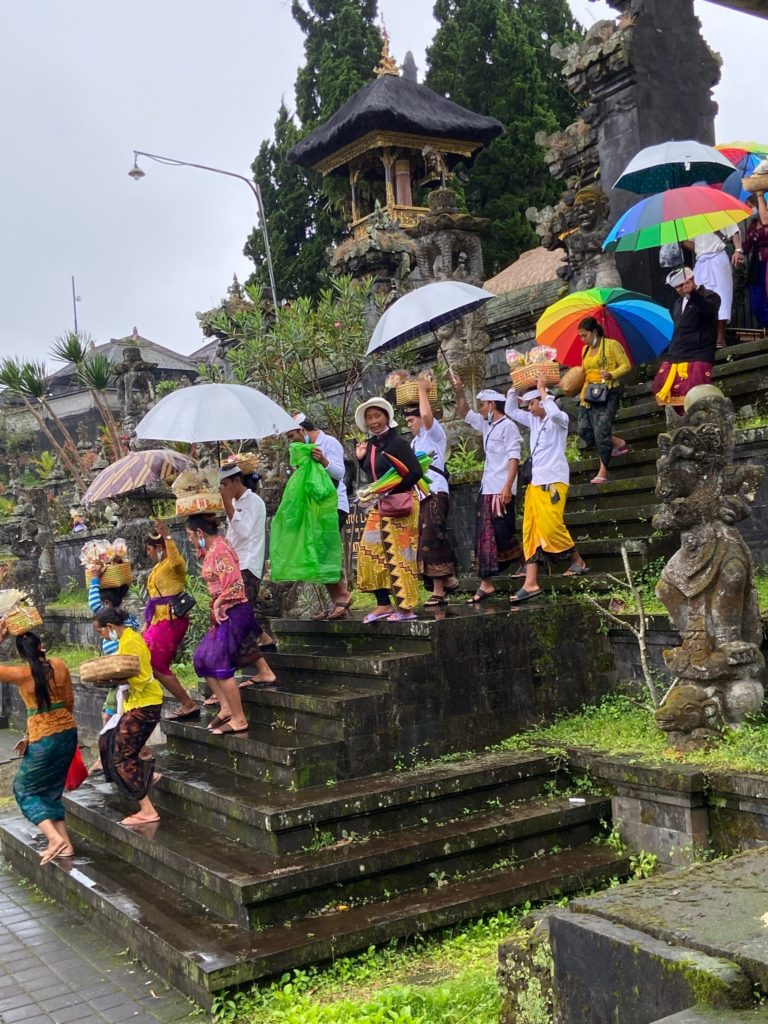
Just outside the Besakih entrance, there are racks of sarongs and traditional clothes for free use by the bules (foreigners). These pop-up Bali clothing kiosks, which often have a sign to encourage donations, are a Godsend to the uninitiated foreigners. Many bule foreigners arrive at the gates in their standard-issue street attire: short shorts or ripped-up blue jeans; skimpy tops or some flesh-revealing, casual beach chic. And that’s just the men. These local habadashers (providers of clothing) are stationed at the racks and oversee lending the sarongs and shoulder-and-breast-covering prayer shawls. These kindly fashion assistants will help customers correctly wrap and tuck sarongs,and cinch up the sash.
Bules sometimes wonder: Why in the name of God does everyone have to make this out-moded fashion statement, just to enter a temple? The bule asking this question has also answered it at the same time. The sarong is required to show respect and allow humans to reflect the beautiful way to the Gods. The small sash around the waist covers up the naval. The naval is considered a source of anger and jealousy. To enter a temple, the supplicants need to have clean and calm auras. The sash is worn to limit the negative energy. Women are also asked to tie their hair back. Loose hanging hair is a sign of someone who is wild and beast-like. Tying back the hair back shows that this wildness is tamed and under control. Menstruating woman are forbidden to enter the sacred Temple grounds. These women are considered temporarily ”unpure.”
As for the author, he needs not borrow Bali clothes. He has a full wardrobe of Bali traditional kit and caboodle. The author can mix and match in local style to enter any Hindu sacred space.
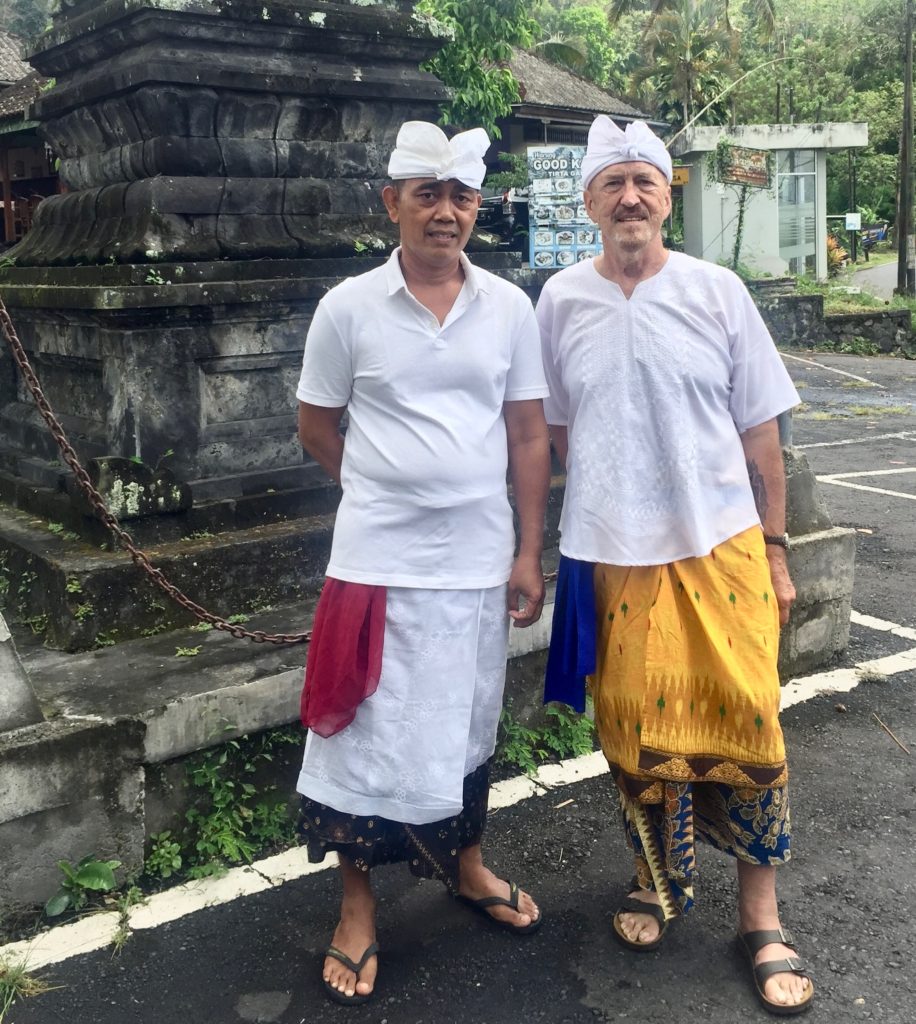
The Origins of Besakih is Prehistoric
Putting aside the above colorful creation story of Rsi Markendaya; the precise origins of the Temple is lost in the mist of time. However, the importance of these Temple grounds as a holy site dates from prehistoric times, well over two thousand years ago. The original Temples were built by ancients who were traditional animists. The animist worhips multiple gods found in the phenomenon of nature — the gods and spirites were embodied in the mountains, streams and forests. The stone foundations of the main Temples are built on top of these aboriginal shrines that resembled megalithic stepped pyramids. The original stone foundations are visible to the observant eye at the bottom of the more ”modern” Hindu Temples overlays. The numerous modern Besakih Temples were built incrementally. The original Temple structures were built in 1284. This date is known for certain as it was the year the first Javenese Hindu invaders took control of Bali. It was these conquerors who first established Bali as a island-wide Hindu fortress; protected from the Islamic culture emerging in nearby Java. Over time, the Temples and their significance blossomed as the architecture grew exponentially in size and complexity. By the 15th century, Besakih had become a state Temple of the powerful Kingdom of Gelgel (as in Dippity Do Original Hair Gel?)
Pura Besakih is treated as a singular event, but Besakih is a sprawling complex. Besakih includes, in just one section out of many, twenty-six different family or clan Temples each with its own shrine. The other Temple sections fan out in all directions. These twenty-six family Temples coexist alongside eighty-six other Temples at Besakih. This entire Temple complex is busy each year with seventy ceremonies or religious observations.
The main and largest Temple in the complex, Pura Penataran Agung, has different areas representing the seven layers of the universe, each layer with its own shrine. All these Temples together are aligned along a single axis and designed to lead the visitor upward and closer to sacred Mount Agung. To accommodate this sprawling enterprise, the Temples are built on six levels, terraced up the slope. The Temples merge to main pivot, the huge Meru at the center of Pura Penataran Agung. This Pura, with its central overarching Meru, is an awesome structure; the holiest of holies for Hindu supplicants, and greatly admired by all comers. Generally, Merus are found in large Bali temples with their characteristic high, overlapping roofs. Merus can reach thirty feet upward or taller. Merus always have an odd number of roofs (1, 3, 5, 7, 9, with 11 being the maximum number) and each roof has its own symbolic meaning.
The twenty-six family Temples sit on parallel ridges ringing the main Temple sanctuary. All these individual Temples lead to Pura Penataran Agung on higher ground. This main sanctuary has stepped terraces and flights of stairs which ascend to a number of courtyards and brick gateways that in turn lead up to the main spire the of Pura Penataran Meru. The symbolic center of this Pura’s main sanctuary is the Lotus Throne, the pivotal architecture and ritual focus of the entire complex. The central Meru of Pura Penataran Agung, along with its Lotus Throne, was added around the seventeenth century.
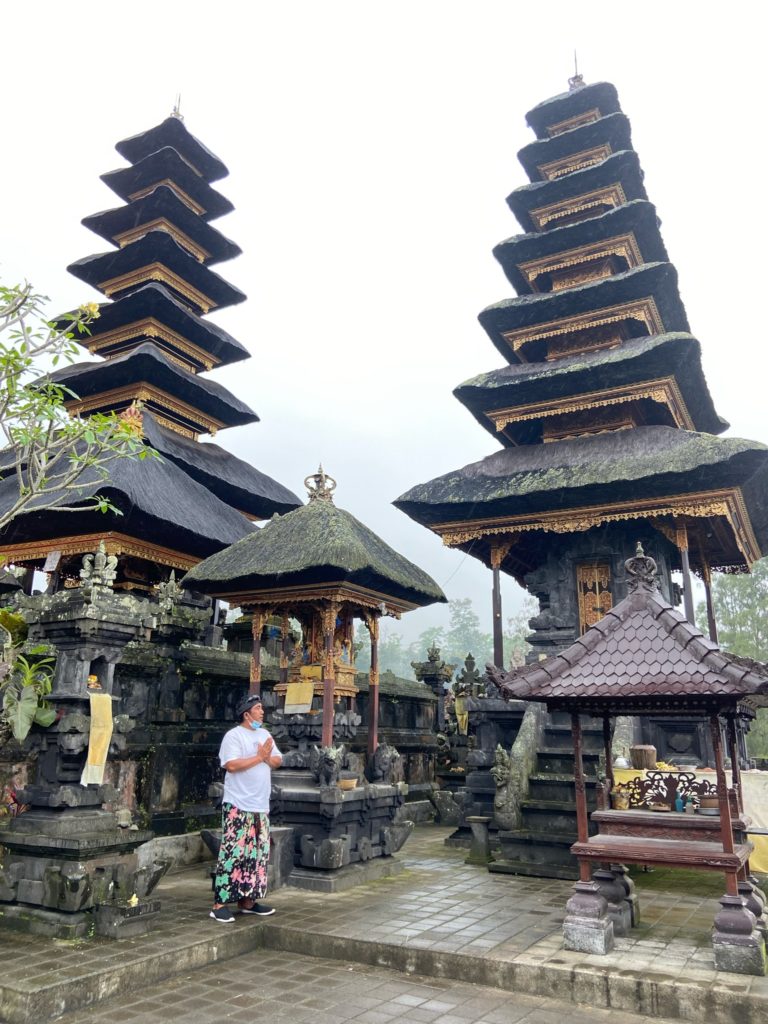
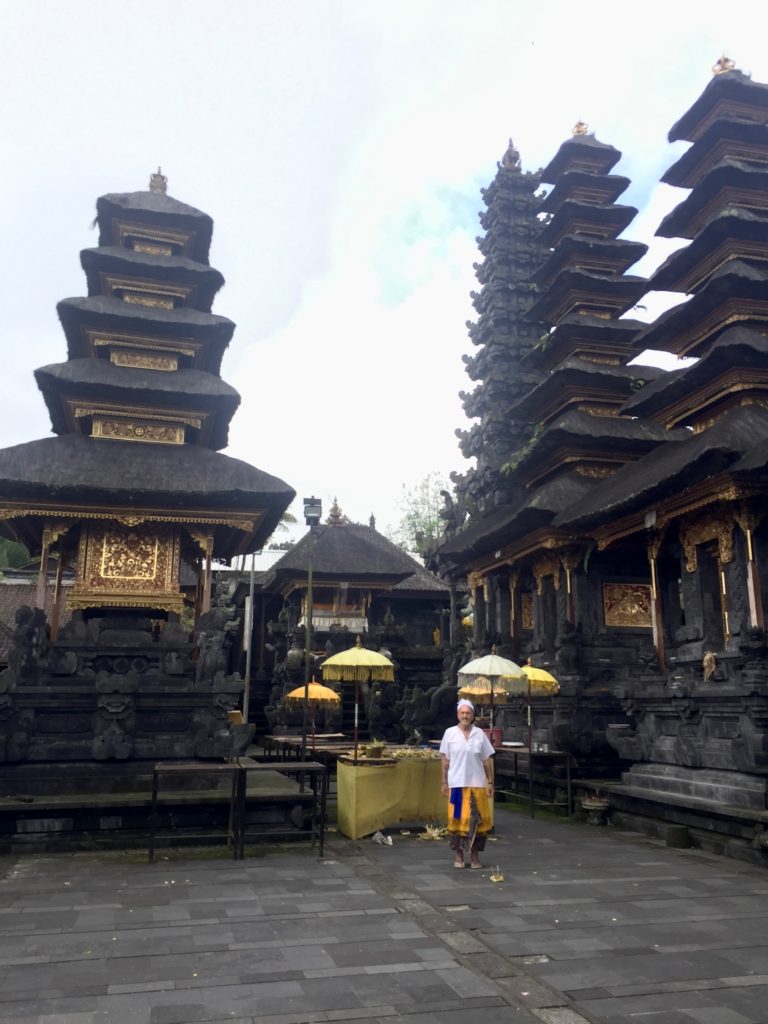
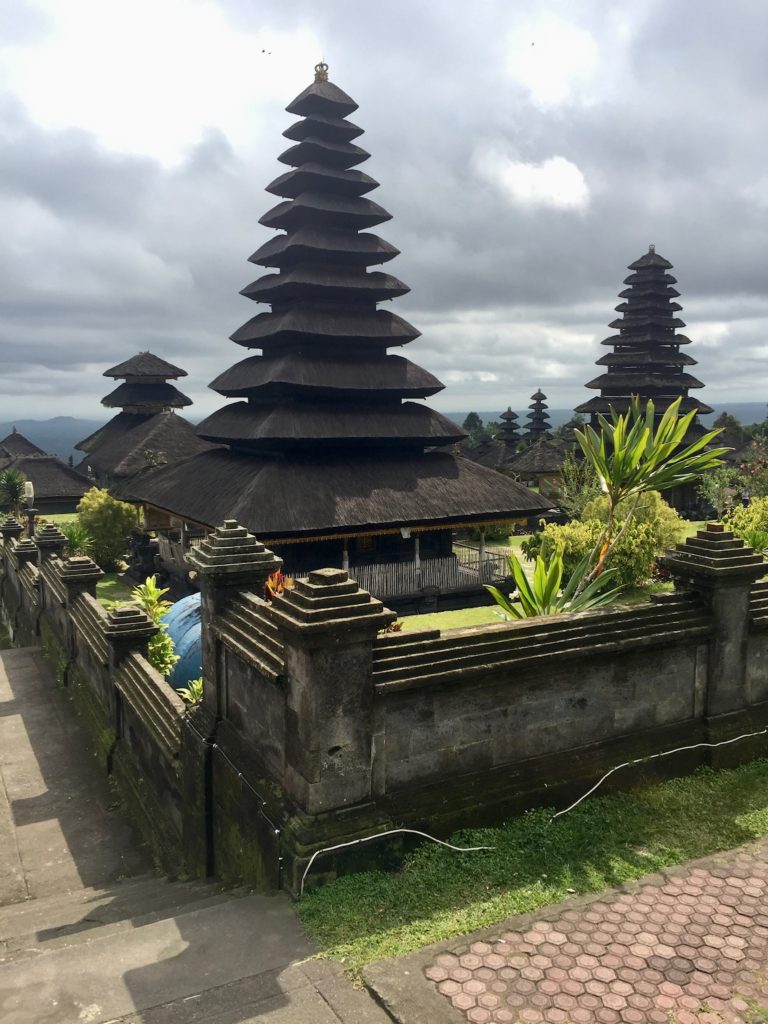
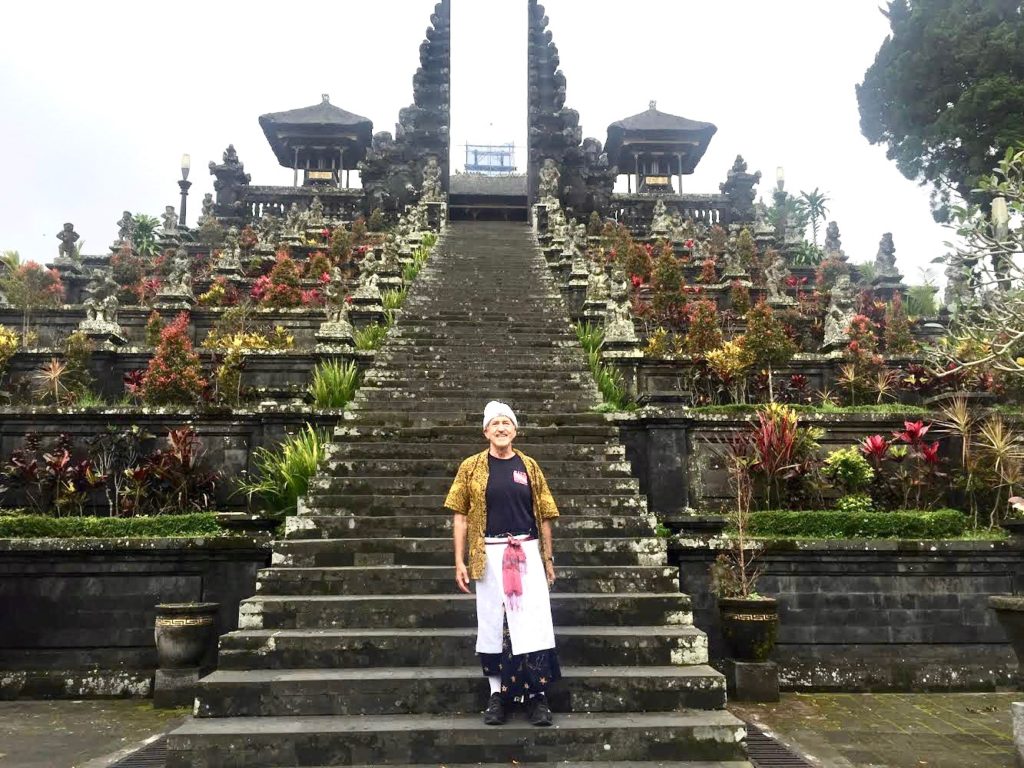
Meanwhile, there are so many different Temple areas, passageways, majestic architecture and crenellations — sorry, got carried away — that some of the most awe inspring sections are almost hidden. The author’s second trip to Besakih lead him on a moderate walk through a wooded area where he stumbled upon an isolated. really ancient Temple complex that is still within the bounds of the Besakih. The local tour guides have to take bules to this segregated complex or foreigners would never find it. Besakih is a religious DisneyWorld. Visitors can not take it all in with just one visit, and need guidance to navigate all the different sections.
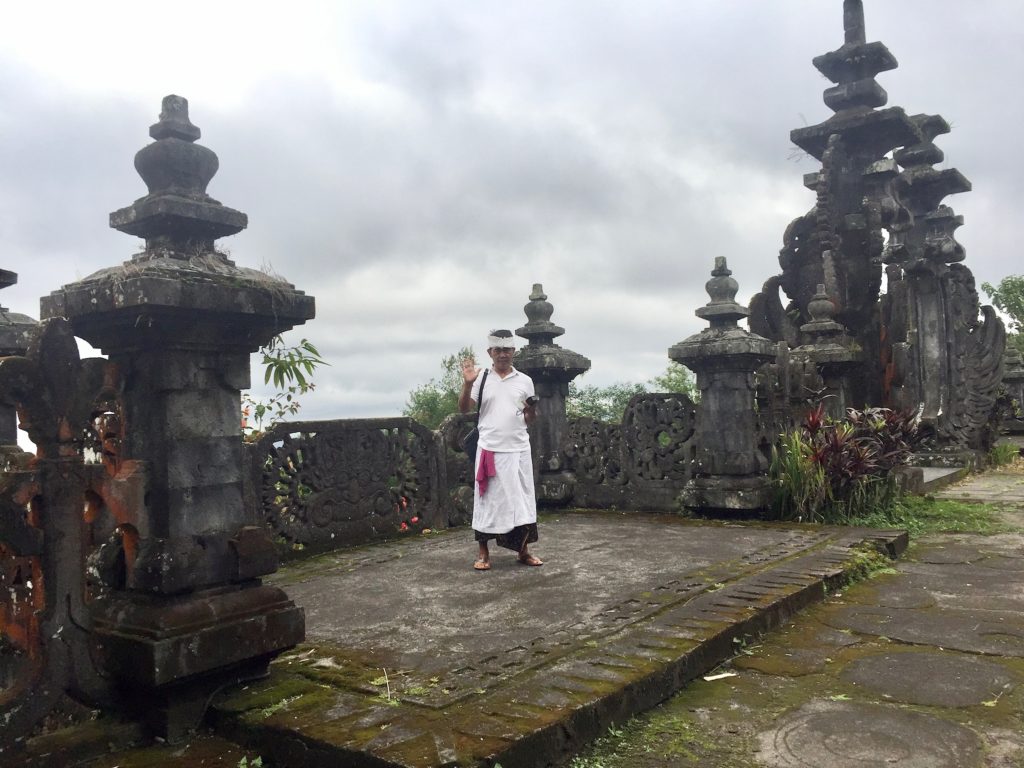
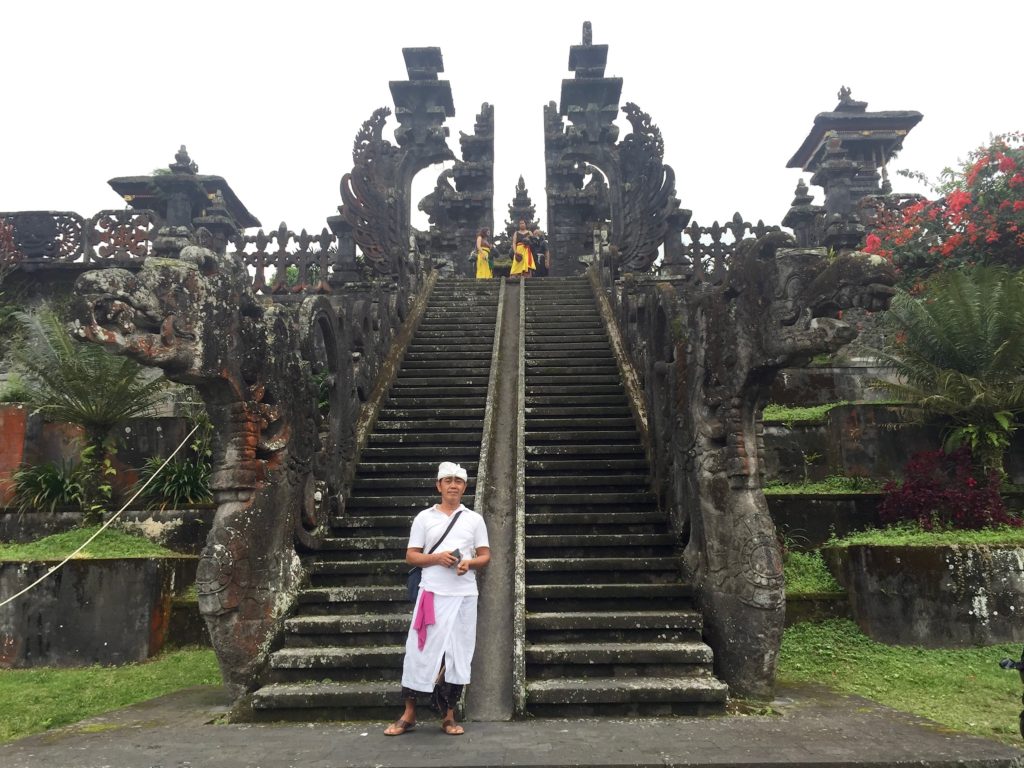
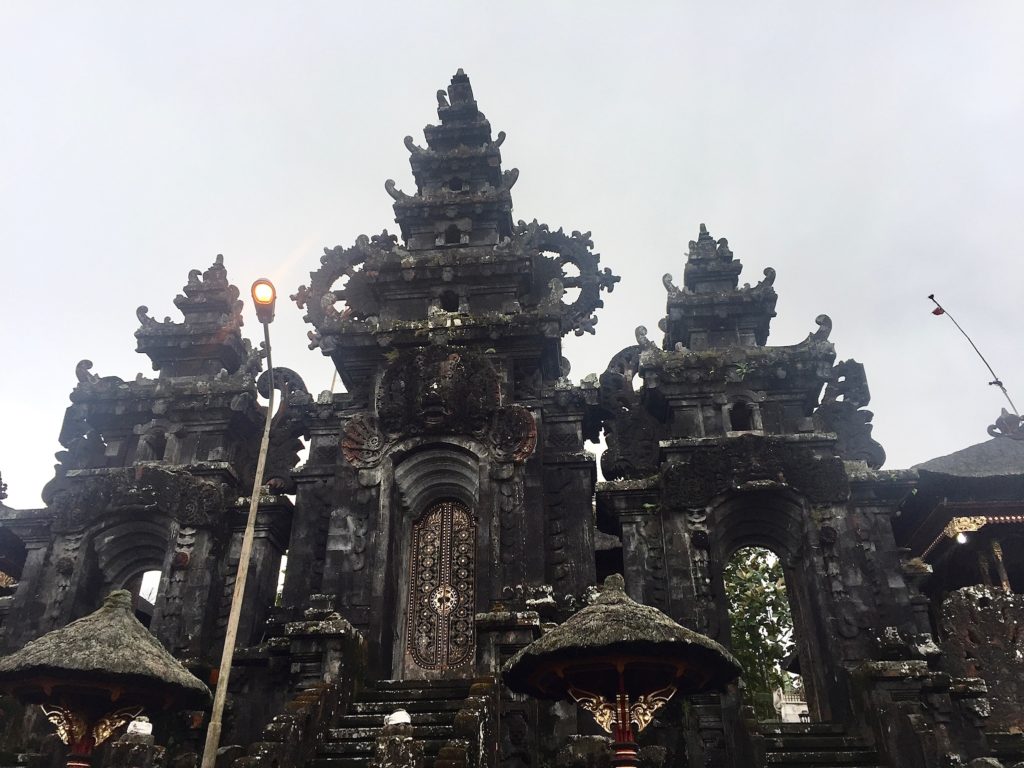
The Awe Inspiring Mount Agung
No discussion of Besakih is complete without connecting it with the nearby sacred, but ferocious, Mount Agung. From its founding, Besakih is devoted to Mount Agung’s Naga Besukih or “Shiva’s Shake,” which is described as both a Dragon God and Dragon Demon. Is it possible to be both at the same time?
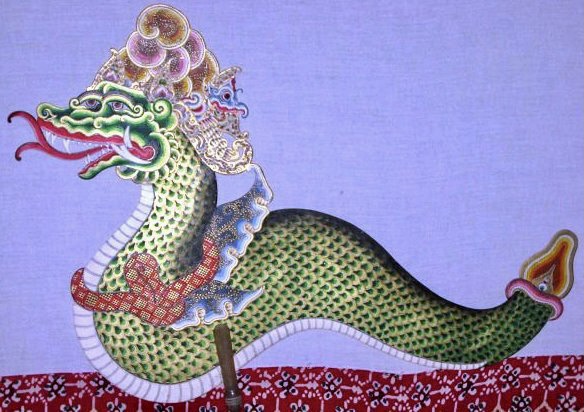
Above and Right: Two colorful representations of the Naga Besukih, the Dragon Demon of Mount Agung. To the uninitiated, this Dragon God looks almost playful. Perhaps these colorful images de-escalate the Balinese fear of this Demon Dragon. Do not be fooled: the Naga Busahih is one of most wrathful and ferocious of Bali supernatural evil creatures. Do not mess with Naga Busahih.
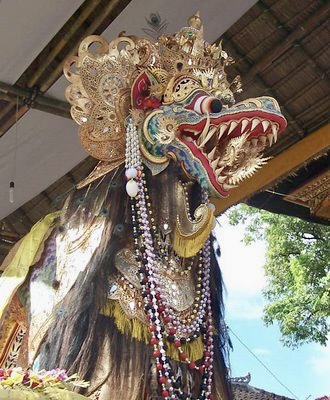
Throughout history, the Mount Agung Dragon Demon has demonstrated its literal and metaphorical powers in tremendous volcanic explosions. In 1963, a series of eruptions by Mount Agung, killed approximately 1,700 people. The volcanic death lava came perilously close to Pura Besakih. The lava flows missed the Temple complex by only a few yards. The Temple’s narrow escape is regarded by the Balinese people as miraculous. Sparing the Temple from destruction was a signal from the Gods of their benevolence wrapped up in a powerful demonstration of the their power. The Hindu Gods were not blindly wrathful: they tempered the destruction with mercy towards Besakih, the Gods’ sanctuary and the sanctuary of their faithful adherents. Below are the before and after photos the 1963 eruption:
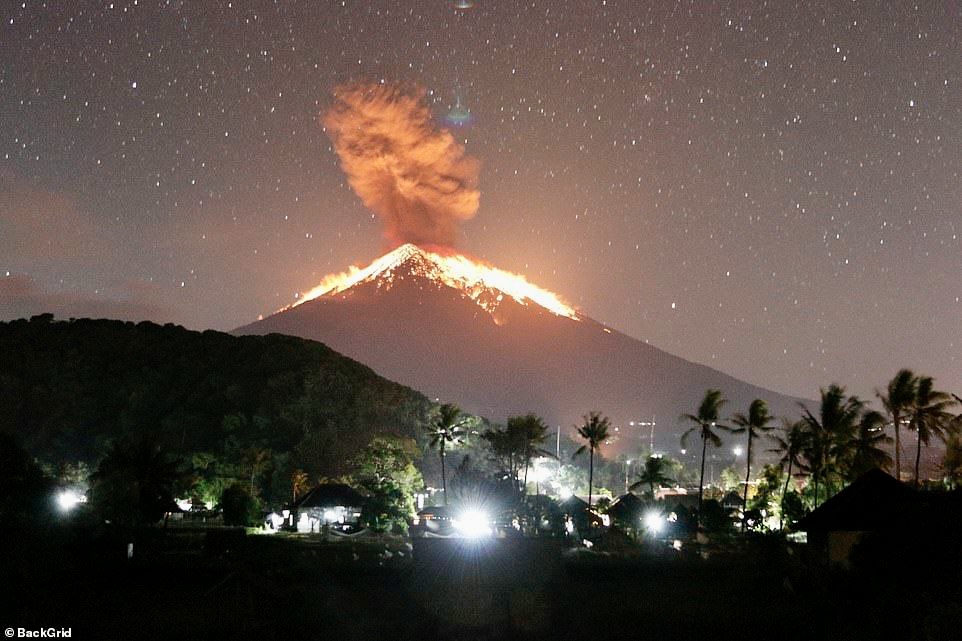
Above. Here comes the 1963 lava flow, heading towards the town below. This 1963 event forever etches in the minds of the Balinese. The locals still ask each other: Where were you on that night in 1963? They all remember. Right: There goes the lava, hidden under a gray cloud of death; and heading right towards Besakih, only to halt a few yards from the Temple grounds.
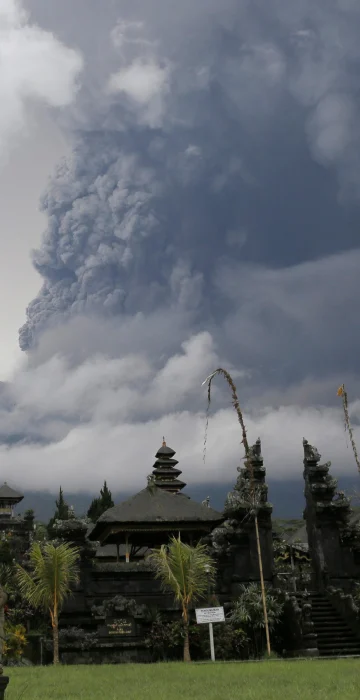
In short, beautiful Besakih and Mount Agung are chock-a-block full of dense symbolism and bedazzling stories. These lessons and sacred connections are carried deep in the hearts of the Balinese. Yet, Besakih and Mount Agung are more then just awe-inspiring Temples for Hindu worshippers. They are dream locations, not only for intrepid tourists; but also religious pilgrims, anthropologists, archeologists, geologists, seekers of the sacred…. and the list goes on! There is something for everyone at Pura Besakih.
From architecture to zazzle (charming style), Besakih has it all …. it doesn’t get any better than this:
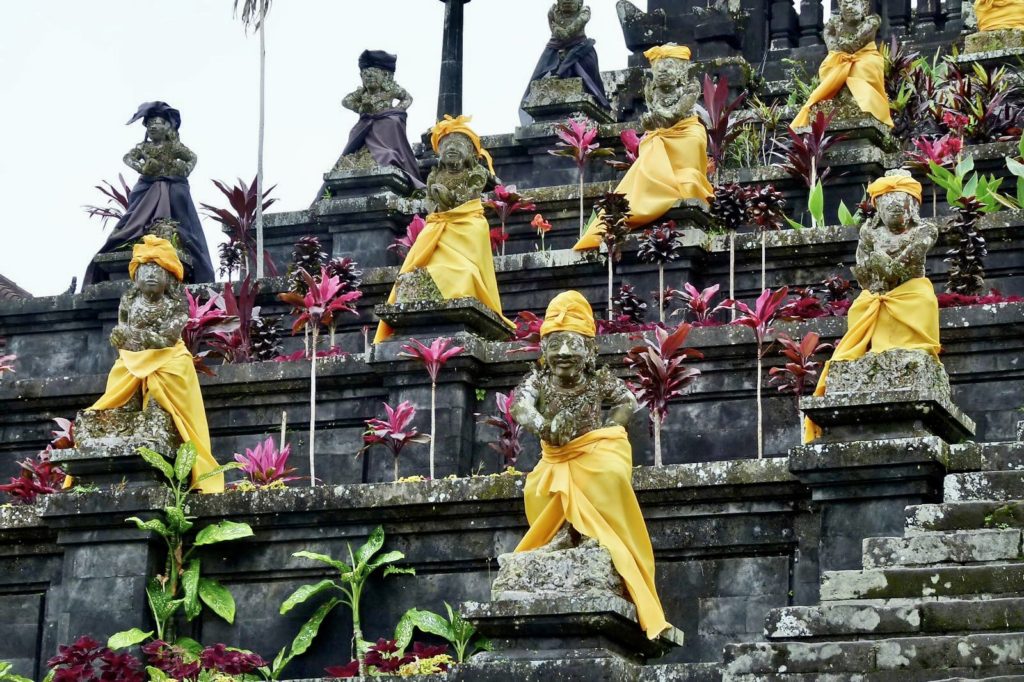
Please sign up below and subscribe to this website, a travelogue and literary journal. You will receive email notices of all new articles posted, about three a month. Email or other information will never be sold or used in any other way.
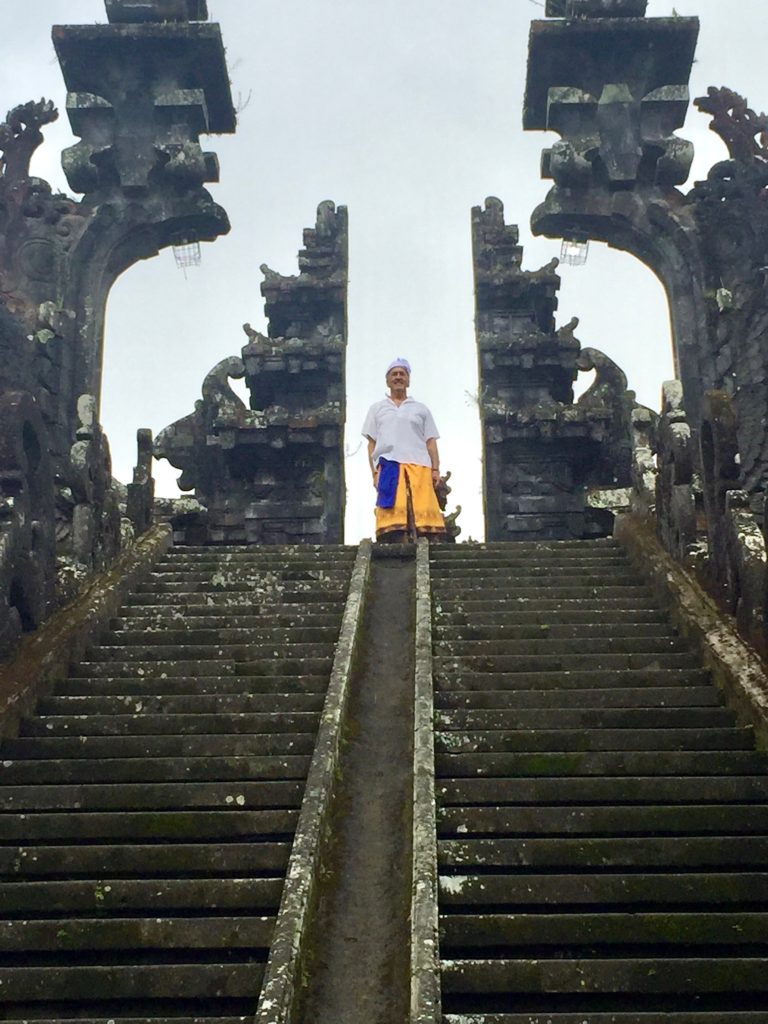
Nice outfits Zephyr! and nice pictures of the temple too!!
good pictures good description and history lesion